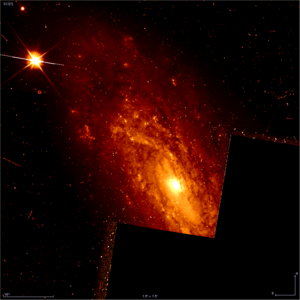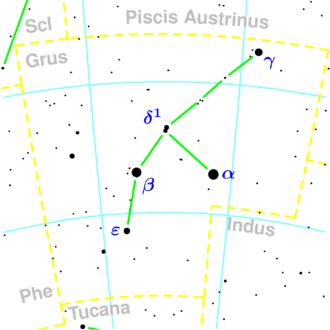NGC 7590
| Galaxy NGC 7590 |
|
|---|---|

|
|
| Photo from the Hubble Space Telescope | |
| AladinLite | |
| Constellation | crane |
|
Position equinox : J2000.0 , epoch : J2000.0 |
|
| Right ascension | 23 h 18 m 54.8 s |
| declination | -42 ° 14 ′ 21 ″ |
| Appearance | |
| Morphological type | S (r?) Bc Sy2 |
| Brightness (visual) | 11.3 mag |
| Brightness (B-band) | 12.1 mag |
| Angular expansion | 2 ′, 6 × 1 ′, 0 |
| Position angle | 36 ° |
| Surface brightness | 12.2 mag / arcmin² |
| Physical data | |
| Affiliation | Grus Quartet, LGG 472 |
| Redshift | 0.005255 (± 0.000017) |
| Radial velocity | +1575 (± 5) km / s |
|
Stroke distance v rad / H 0 |
(69 ± 5) · 10 6 ly (21.3 ± 1.5) Mpc |
| history | |
| discovery | James Dunlop |
| Discovery date | July 14, 1826 |
| Catalog names | |
| NGC 7590 • PGC 71031 • ESO 347-33 • MCG -7-47-30 • IRAS 23161-4230 • 2MASX J23185483-4214206 • SGC 231610-4230.7 • GC 4929 • h 3980 • Dun 477-1 | |
NGC 7590 is a spiral galaxy of Hubble type bc SA (rs)? in the constellation crane in the southern sky . The galaxy has an angular extent of 2 ′, 6 × 1 ′, 0 and an apparent magnitude of 11.3 mag. It is around 69 million light years away from the Milky Way and has a diameter of around 60,000 light years . It is cataloged as a Seyfert 2 galaxy , a special type of very bright galaxies that belong to the group of active galactic nuclei (AGN).
Together with NGC 7552 , NGC 7582 and NGC 7599 , it forms the Grus Quartet.
The object was discovered by James Dunlop on July 14, 1826 .
Web links
Commons : NGC 7590 - Album containing pictures, videos and audio files
